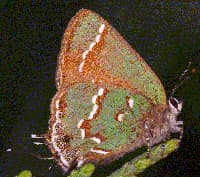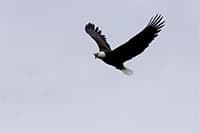Home → Fish & Wildlife → Wildlife → Endangered & Threatened Species → Listing and Delisting Process
Listing and Delisting Process
Listing Process
The Maine Endangered Species Act [MESA] gives the Commissioner of MDIFW the authority to make recommendations for listing species that are at risk of becoming extinct in Maine. The Act states the purpose of MESA.
§12801. Declaration of purpose
The Legislature finds that various species of fish or wildlife have been and are in danger of being rendered extinct within the State of Maine, and that these species are of esthetic, ecological, educational, historical, recreational and scientific value to the people of the State. The Legislature, therefore, declares that it is the policy of the State to conserve, by according such protection as is necessary to maintain and enhance their numbers, all species of fish or wildlife found in the State, as well as the ecosystems upon which they depend.

Photo Credit: Alan Chin-Lee
Listings of a species, and the subsequent management of that species, are two distinct steps.
- Listing – Listing is the structured, systematic, and scientific examination of the interacting factors that qualifies a species as a candidate for listing as an Endangered or Threatened species in Maine.
- Management – The listing of a species (in any category) does not automatically ensure a given level of management, nor does it automatically commit resources or programs for that species. Those commitments are part of a subsequent and separate step to the listing process.
Separating these two steps allows the Department to recommend species for listing based solely on biological facts, thus purely reflecting the species' likelihood of extinction within Maine. The Department makes the decision without being constrained by political pressures; limits on agency funding, staffing, or management capabilities; the ease or difficulty of managing a species; or by a species' potential responsiveness or lack of responsiveness to management.
By having a second step, more thoughtful and refined management decisions are possible. The feasibility, desirability, and practicality of management options can be considered during the second step, along with the management and regulatory jurisdictions of other state, tribal, and federal agencies. This second step is addressed primarily in MDIFW's species planning process as outlined in Maine's Wildlife Action Plan.

Photo Credit: Dave Tibbetts
In summary, the first step recognizes and documents biological concerns for a species by listing it in one of four categories, and the second step looks pragmatically at programs for its protection and recovery.
The Maine Endangered and Threatened Species Listing Handbook (PDF) covers all aspects of the Department's Endangered Species Listing process, including both regulatory and policy level components. The Maine Endangered Species Act [MESA] statutorily establishes the categories of "endangered" and "threatened" species. Species are added to, or deleted from, these categories via recommendations by the Commissioner of MDIFW to the Legislature, and ultimately, approval by the Legislature. Other administrative categories (special concern and extirpated) are established by policy, not by regulation, and are used for planning and informational purposes; they do not have the legal weight of the first two categories.
By rule, the Department must review all species under its authority once every eight years to determine which species qualify for listing. During this comprehensive review, Department biologists, guided by the Maine Endangered and Threatened Species Listing Handbook compile a list of likely candidates for listing and distributes it to species specialists in Maine and elsewhere. Based on input from these specialists, the Department may revise the list before presenting it to the public at public hearings. Ultimately, the Department submits its final recommendation to the Legislature for their approval. The last comprehensive review was in 2022, with the Legislature approving the recommendations of the Commissioner (effective October 25, 2023).

Photo Credit: Jonathan Mays
The rule (MS Word) also has a provision whereby the public can initiate listing of a species. The rule states, "Requests to add, change, or remove species on the lists may be submitted to the Commissioner for review and recommendation no later than six months before the start of the next legislative session. Each request must include a completed and current "Maine Endangered and Threatened Species Listing Review Work Sheet" and scientific documentation that the species meets the criteria for an endangered or threatened species. Guidelines for completing the worksheet can be found in a current version of the "Maine Endangered and Threatened Species Listing Handbook."
Delisting Process

Photo Credit: Steve Hillebrand, USFWS
12 §12810. Delisted Species
- Definition. For purposes of this section, "delisted species" means a species that was listed as a state endangered or threatened species under section 12803 and after 2007 was removed from that list by the Legislature. The following is a delisted species:
- Bald eagle, Haliaeetus leucocephalus. [2009, c. 60, §2 (NEW).] [ 2009, c. 60, §2 (NEW) .]
- Prohibited acts regarding delisted species. Except as otherwise authorized by the commissioner pursuant to this Part, a person may not intentionally:
- Import into the State or export out of the State a delisted species. A person who violates this paragraph commits a Class D crime; [2009, c. 60, §2 (NEW).]
- Hunt, trap or possess a delisted species within the State. A person who violates this paragraph commits a Class D crime; [2009, c. 60, §2 (NEW).]
- Process, sell, offer for sale, deliver, carry, transport or ship, by any means whatsoever, a delisted species or any part of a delisted species. A person who violates this paragraph commits a Class D crime; or [2009, c. 60, §2 (NEW).]
- Feed, set bait for or harass a delisted species. A law enforcement officer, as defined in Title 25, section 2801-A, subsection 5, must issue a warning to a person who violates this paragraph for the first time. A person who violates this paragraph after having previously been given a warning under this paragraph commits a Class D crime. [2009, c. 60, §2 (NEW).]